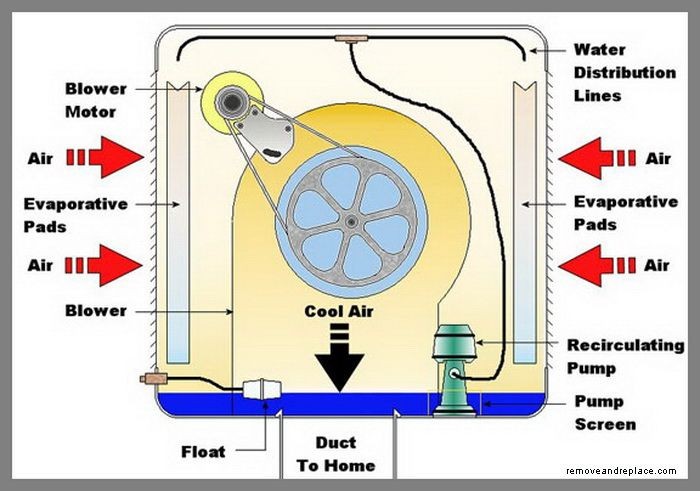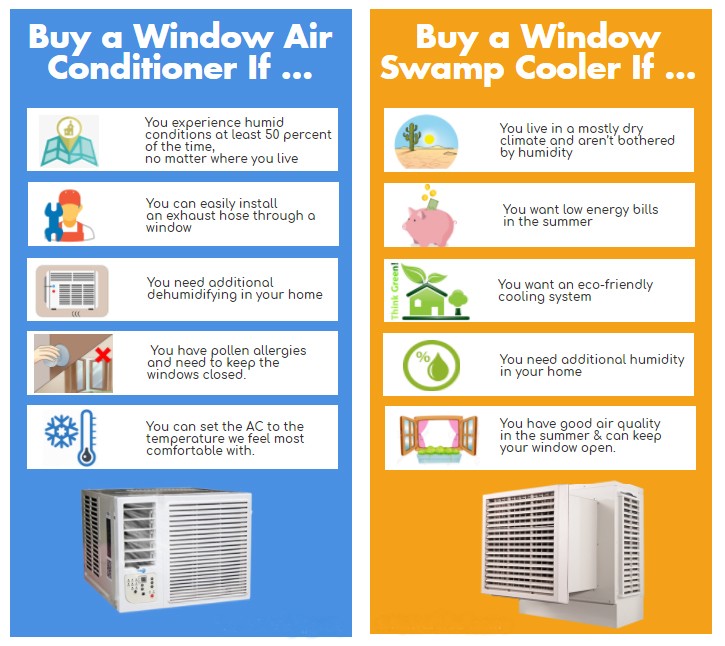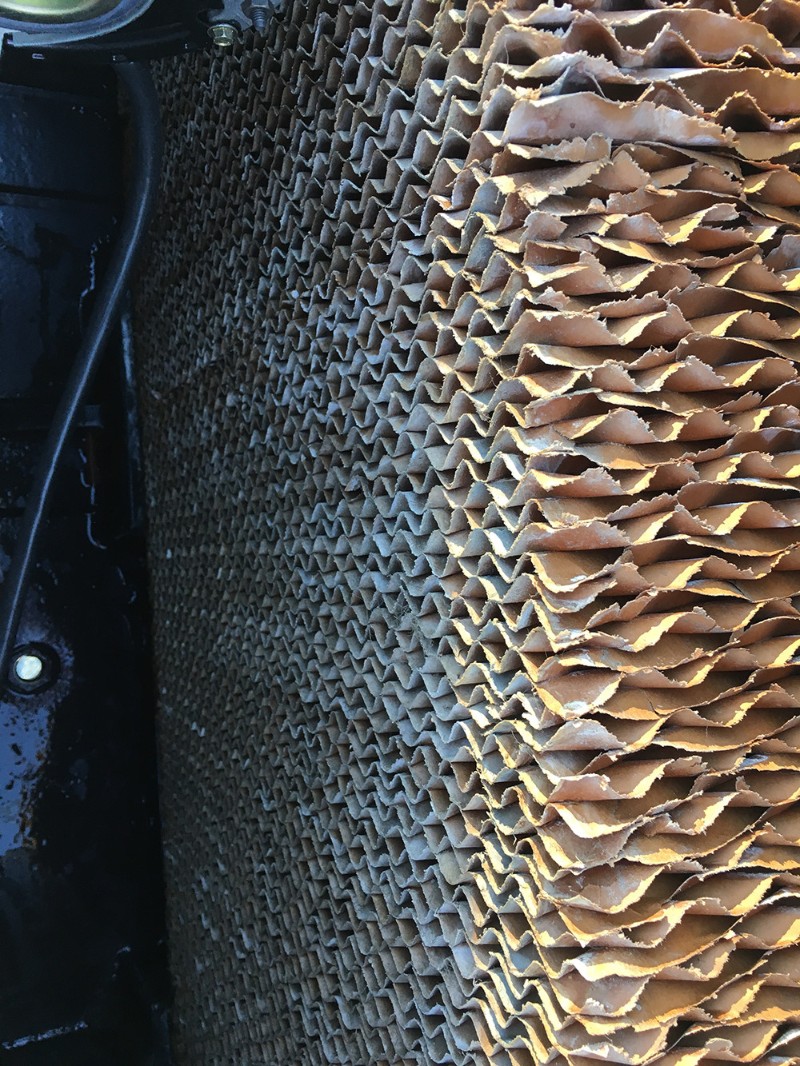Tips to Make Your Swamp Cooler Colder and More Efficient
November 5, 2018 4:28 pm Leave your thoughtsHow to Make an Evaporative Cooler Colder
Evaporative coolers are prevalent in the dry climates of the West, and they can be less expensive to operate than traditional air conditioners. They can also be extremely efficient and even add humidity to your interior air, which makes them even more useful. If you need to make your unit throw colder air, you can try placing it on the side of the house which gets a lot of shade, and then open a window on the opposite side of the house. More useful information on swamp coolers, as they are sometimes called, is described below.
How Do Swamp Coolers Work?
Swamp coolers work by using a process called evaporative cooling, and these are most often used in very dry areas such as those out in the American West. Evaporative cooling can add moisture to the air by taking warm external air through wet cooling pads, which in effect cools that air. This cooled-off air is then distributed throughout a home by a blower motor which has been installed in a vent.
The main parts of an evaporative cooler are the evaporative pads, water distribution lines, a water supply valve, a pump, a float, and a blower. The pads serve as liners on the inside of the cooler, and they have the function of cleaning and cooling the air. Water distribution lines carry water to all other components of the unit as needed.
The water supply valve is connected by a copper tube to the cooling unit itself and it supplies the swamp cooler with water. The pump forces water through the distribution lines, and this is what keeps the pads wet at all times. When the water level in the bottom of any swamp cooler achieves a high enough level, it causes the float to rise to the top of the water, thereby shutting off the water supply valve.
A blower motor is responsible for causing the blower to turn, and that brings cooling airflow through the ductwork, and this airflow gets forced to the external area of the home, cooling the inside temperature in the process.

How Does Climate Play a Role?
Climate of an area where an evaporative cooler is being used definitely comes into play in the operation of the unit. The temperature of dry airflow drops in a major way as it passes through the transition from liquid water to water vapor, and the normally high temperature of a hot region makes this transition even more stark.
It also has the effect of cooling the airflow off by using much less energy than normal refrigeration techniques require. In climates which are normally extremely dry, evaporative cooling can add another benefit by introducing additional moisture into the environment to make people more comfortable.
What to Do Before First Use of the Season
Before using your cooler for the first time in any warm season, there are some steps you should take to ensure that it will function efficiently throughout the entire season. First of all, you should clean off any debris and disassemble it before giving it a thorough cleaning. Then you should change the pads of your evaporative unit, and you should purchase some extra ones, because it may be necessary to swap out the pads during the season as well. Then all you have to do is reassemble your evaporative unit, reconnect the waterline, and inspect it for leaks. The last step involves simply turning on the unit, and allowing it to run for a while so you can ensure that it’s ready to go.
Will Opening a Window or Two Help?
Surprisingly, it is generally advisable to have a window or two cracked open while you’re running your cooler, and there’s a specific reason for this. Climate control as measured from inside a home, will always depend on having an appropriate balance to the indoor temperature. In order to maintain a comfortable level of humidity inside, it will be necessary to ensure that you have the same volume of airflow being forced out of your home, as the level of air which is being pumped in.
The best way to ensure a proper balance between exhausted airflow and incoming air is to either install ducts in every room, or to slightly open at least one window in each room. You have to be fairly careful about how wide open you make these windows though. Each window that you open should only be open wide enough to allow pressure from the room to quietly close any door which has been opened in that room.
When you give it the door test and close the door, you should make note of whether the door closes forcefully or quietly. If the door happens to close very forcefully, it means the exhaust level of the airflow is too low, and you should open the window a little wider. If it turns out that the door won’t close at all, or it only closes with great difficulty, that means the window is probably open too wide, and you should shut it down before conducting the door test again.

How Does Regular Maintenance Help?
While evaporative coolers are more efficient than conventional portable conditioners, they generally require a little more maintenance than do their traditional counterparts. By regularly maintaining your unit, you can ensure that it’s ready to provide you with cool air throughout the warm season. It’s sometimes necessary to perform additional maintenance during summer, but it’s still worthwhile because it’s very easy maintenance that anyone can do, and it will guarantee that you continue to receive the benefits of your evaporative cooling unit.
For the most part, all you have to do is clean the unit inside and outside, check the belts, change the cooling pads, and make sure the water distribution system has no leaks. Just a little attention to maintenance goes a long way toward keeping your unit operational, and providing you with the cooling you need in warm weather.
As we’ve covered in previous posts, residential evaporative coolers (also known as swamp coolers) offer one of the best ways to cool your home. They’re energy efficient, they’re better for the environment than an AC unit and they’re just as effective as running an expensive whole-home AC. But what you might not know is that proper use of a swamp unit can increase its effectiveness, thus increasing your comfort level on hot days. Continue reading to learn best practices for your new unit:
- Know where to use it: The biggest downside regarding swamp coolers is that they’re not effective in all climates. Swamp coolers work by adding cold moisture to hot, dry air. So, if you run your unit in a humid environment, where the airflow is already saturated with water, it’s not going to work. Luckily, we live in the desert, so a cooling unit is almost always effective.
- Prime your pads: Before you start running your cooling unit, make sure your swamp cooler pads in Phoenix, AZ are nice and wet. Before you turn on the fan (and start using electricity), make sure your cooler’s reservoir is full and the pads are fully saturated with water. Doing so will ensure that you’re blowing cold air throughout your home while you’re using the unit.
- Use cold water: Studies have shown that filling your reservoir with 50-degree water yields the best results for cooling the air. The warmer the water gets, the less effective your cooling unit is going to be. Keep an eye on the reservoir and consider filling it back up with fresh water every once in a while.
- Open the windows: When you run your AC, you want to keep your doors and windows shut, as air conditioners work best in a sealed environment. But folks with these coolers should consider cracking their windows while it’s running. As mentioned above, an evap unit is more effective in an arid environment, so letting a little bit of that dry desert air inside will make your unit work better.
- Use a dehumidifier: Again, we’re trying to keep the air as dry as possible when we have the unit running. One of the best ways to do that (along with cracking the windows) is to run a dehumidifier. For best results, place your dehumidifier near the intake grill, so the driest air possible flows over your swamp cooling pads in Phoenix, AZ.
- Maintain your cooler: Swamp coolers are like any other appliance in your home—they’ll provide the best results if they’re maintained regularly compared to air conditioners. In addition to wiping down the exterior, washing the water reservoir and replacing your cooling unit pads when they start to get old, we recommend calling a professional to inspect and maintain your unit every year. A quick inspection by a pro can ensure an efficient and long-lasting cooler.
Don’t have a swamp cooler yet? Give Premier Industries Inc. a call! We can quickly install a cooler so you can get a refreshing reprieve from the desert heat. Drop us a line on our contact page.
Evaporative coolers are typical in dry western climates and are much cheaper and easier to run than traditional air conditioners. Besides, they are very efficient and add humidity to your house atmosphere, making it a useful tool.
If you need to make your evaporative cooling unit release colder air, you can strategically position it on one corner of your house where there is usually plenty of shade. Once it is settled at the corner, open the window that is on the opposite side.
Here is more information on how to make your swamp cooler colder and more efficient.
Experiment with Positioning
Manufacturers make swamp coolers for cooling one room at a time instead of the whole house. When you purchase a cooling unit, confirm the product description of how many square meters are proposed and the airflow ranking in Cubic Feet per Minute.
Ensure that you use a cooling unit in a sizeable room to maximize efficiency. Additionally, you can position the cooling unit in a specific location so that it’s fan gusts cold air directly towards your bedroom or dining area.
Positioning it this way will give you the coldest air, which will be focused right where it needs to be. This also gives you the desired breeze from the fan to your skin. To get that perfect position to place a swamp cooler, move it around until you find the optimal location in every room of your choice.
One great idea is to place the cooling unit near a cracked window to take in dry air from outside and pass on better air in the room.
Make use of Plant Life.
Another method that you can use to reduce humidity in your house is by using household plants. The plants suck up excess moisture in the air around a room.
Various plants have adaptive capabilities to absorb water from the air instead of the soil. These plants include Yucca, English Ivy, Cacti, Air plants, Succulents, Peace Lily, Boston Fern, Euphorbia, Bromeliads, and Aloe.
Prime Your Pads
Your swamp cooler has an absorbent medium known as cooling pads that allows air to go through them allowing moisture evaporation. The cooling pads take time to absorb water thoroughly. To make them wet; you can first soak them with water. Once they are completely soaked, they will quickly wick moisture from the cooling unit’s tank to maintain their wetness.
With most coolers, you have to fill the water tank and give the pads time to absorb the water before switching on the unit. Remember always to top up the tank’s water as the water gets lower as the pads soak in it.

Opening a Window
Sometimes, your house can be hotter than the humidity outside, even when your cooling unit is on. Such a situation means there is no proper air circulation in your room, and the air might reach saturation point quickly and diverge the cooling effect of your cooler.
If this is the case, you should open windows slightly to cycle the laden moisture out of the room and restore it with dry air from outside. The dry air from outside allows your cooling unit to work more efficiently and even cool your room faster.
Cold Water Instead of Ice
What is the best water temperature that can give you the most undisturbed airflow from your cooler? It is cold water.
Avoid adding ice to the tank at all costs since it will only produce a rush of cold air initially and then normalizes after the evaporation process occurs.
Maintenance
Despite practicing ways discussed above of making your cooling unit colder, there is need to keep it working more efficiently. Like any other equipment, your unit needs proper maintenance for optimum performance and to last longer.
It needs to be cleaned regularly, at least twice or thrice annually or after every season.
It is vital to inspect your unit during summer to check for any possible issues that it might have before switching it on.
Here are a few things you have to do before running your swamp cooler:
- Clean the fan, intake grill, and air outlet using a vacuum cleaner
- Check the cooling pads and replace old ones with new ones in case they are faulty
- Wash your coolers reservoir with a mixture of clean water and white vinegar and with a thorough rinse with fresh water afterward
When you properly maintain your cooler, place it in a strategic position if it is a portable unit; you will receive colder air from your cooler.
Categorised in: Swamp Cooler Pads
This post was written by Mike Nicolini
